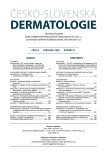Contact Allergy to Epoxy Resins
Authors:
I. Karlová
Authors‘ workplace:
Klinika chorob kožních a pohlavních FN a LF UP Olomouc
Published in:
Čes-slov Derm, 91, 2016, No. 3, p. 115-117
Category:
Case Reports
Overview
Sensitivity to epoxy resins is a common cause of allergic contact dermatitis which often occurs during work with uncured epoxies. Hardened epoxy resins loose their irritant and allergic potential. Contact allergy may appear to epoxy resins, hardeners and other substances of epoxy systems. The most affected professions are lacquerers, floor workers and workers in electronic industry. A typical case of professional contact dermatitis to epoxy resins in pacient who worked as lacquerer with epoxy paints is reported. The patient presented with eczema eczema on the face and on the forearms. The contact allergy to epoxy – resin Bisphenol A which is included in European Standard Series of Patch Test Allergens, was proved by patch testing. After elimination of contact with epoxy resins the contact allergy symptoms gradually disappeared.
Key words:
contact allergic dermatitis – epoxy resins – professional exposition
Sources
1. AALTO-KORTE, K., SUURONEN, K., KUULIALA, O. et al. Screening occupational contact allergy to bisphenol F epoxy resin. Contact Dermatitis, 2014, 71, p. 138–144.
2. BANGSGAARD, N., THYSSEN, J. P., MENNÉ, T. et al. Contact allergy to epoxy resin: risk occupations and consequences. Contact Dermatitis, 2012, 67, p. 73–77.
3. DASTYCHOVÁ, E., DOBEŠOVÁ, J., HORAŽĎOVSKÝ, J. et al. Vývoj kontaktní přecitlivělosti na alergeny Evropské standardní sady v České republice v průběhu let. Čes-slov. Derm., 2014, 89, 3, s. 108–127.
4. GEIER, J., KRAUTHEIM, A., UTER, W. et al. Occupational contact allergy in the building trade in Germany: influence of preventive measures and changing exposure. Int. Arch. Occup. Environ. Health, 2011, 84, p. 403–411.
5. GEIER, J., LESSMANN, H., HILLEN, U. An attempt to improve diagnostics of contact allergy due to epoxy resin systems. First results of the multicentre study EPOX 2002. Contact Dermatitis, 2004, 51, p. 263–272.
6. JOLANKI, R., KANERVA, L., ESTLANDER,T. et al. Occupational dermatoses from epoxy resin compounds. Contact Dermatitis, 1990, 23, p. 172–183.
7. MACHOVCOVA, A., DASTYCHOVA, E., KOSTALOVA, D. et al. Common contact sensitizers in the Czech Republic. Patch test results in 12,058 patients with suspected contact dermatitis. Contact Dermatitis, 2005, 53, p. 162–166.
8. RIETSCHEL, R. L., FOWLER, J. F. Fischer's Contact Dermatitis. 5. vydání. Philadelphia USA, Lippincott Williams & Wilkins, 2001.
9. RIETSCHEL, R. L., MATHIAS, C. G., FOWLER, J. F. et al. Relationship of occupation to contact dermatitis: evaluation in patients tested from 1998 to 2000. Am. J. Contact. Dermat., 2002, 13, p. 70–176.
10. ROMYHR, O., NYFORS, A., LEIRA, H. L. et al. Allergic contact dermatitis caused by epoxy resin systems in industrial painters. Contact Dermatitis, 2006, 55, p. 167–172.
11. WONG, C. L., GHASSABIAN, S., SMITH, M. T., LAM, A. In vitro methods for hazard assessment of industrial chemicals – opportunities and challenges. Front Pharmacol., 2015, 6, p. 94.
Labels
Dermatology & STDs Paediatric dermatology & STDsArticle was published in
Czech-Slovak Dermatology

2016 Issue 3
Most read in this issue
- Allergy to Titanium Proven by Patch Tests
- Contact Dermatitis – Part I.
- Contact Allergy to Epoxy Resins
- Trichophytia Profunda as an Occupational Disease in an Immunosuppressed Patient
